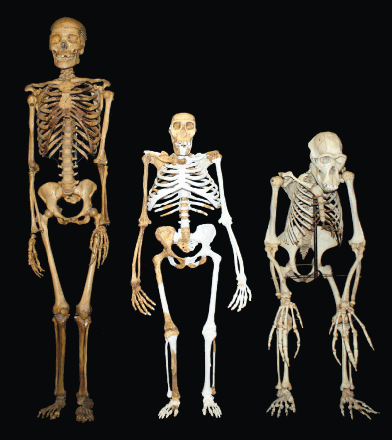Please note: Osher Rainforest will be closed for maintenance Jan. 14–16.
Science News
Au. Sediba and our Family Tree
April 15, 2013
by Molly Michelson

With six research papers in the current issue of Science, and numerous articles and blog posts surrounding those papers, Australopithecus sediba is the hominin du jour.
The papers reveal different anatomical features of Au. sediba and discuss their similarities to, and differences from, early human features. One news article calls them a “hodgepodge,” while another describes them as a “mosaic.”
“Amalgam” is how Zeray Alemseged, the Academy’s curator of anthropology, describes Au. sediba’s combination of human-like and more primitive features. Take the species’ heel. You and I walk by putting our broad and robust heel down and rolling to our toes, but Au. sediba’s heel was so narrow, these hominins couldn’t land on their heel, and likely walked on the sides of their feet and then pronated.
Similarly, Au. sediba’s torso had a conical and quite primitive shape, and their shoulders were “shrugged.” Alemseged explains, “With short necks and a narrow clavicle, they appeared to be ape-like with a substantial adaptation for climbing.”
However, the lower ribs were slightly human-like and the teeth were a mixture “of primitive and human traits,” according to an accompanying article in Science.
The findings are based on fossils found in South Africa by Lee Berger’s team in 2008, and include three skeletons. The recent studies pinpoint Au. sediba’s existence to around 1.98 million years ago and make a few proposals on how to place the species in our lineage. In fact, Berger suggests that Au. sediba could be the direct ancestor to our genus, Homo.
“Lee is a good colleague, but I happen to disagree with him about that,” Alemseged says. “It’s a fascinating discovery and the quality of preservation of the fossils and number of skeletons are great,” but Alemseged sees no evidence that Homo descended from Au. sediba. “The fossil record indicates that by 2.33 million years ago, Homo already exists,” predating Au. sediba, Alemseged explains.
In addition, the findings (especially in regards to the dental study) suggest that Au. sediba was closely related to Australopithecus africanus, but not Australopithecus afarensis, the species Alemseged studies. He finds the evidence linking Au. sediba and Au. africanus solid, but that doesn’t leave Au. afarensis out. Given the timing, Au. afarensis, which lived between 3.8 and 2.9 million years ago, was likely the ancestor of Au. africanus, which lived between 3.3 and 2.1 million years ago and in turn was the ancestor of Au. sediba.
Alemseged notes that the studies underscore the diversity of our lineage. “It’s not surprising, in the natural world, to find multiple species of any given group,” so why should our family tree be any different?
Despite his scientific disagreement with his colleague, Alemseged lauds Berger’s generous sharing of the fossils and studies related to Au. sediba. “He’s introduced a new culture in paleontology of being very open.”
Finally, the image accompanying many of the articles (above right) is very similar to an animation comparing Au. afarensis, humans and chimpanzees in the Academy’s current exhibit, Human Odyssey that Alemseged curated. If you haven’t visited it yet, it explores Australopithecus, Homo, and more!
Image: Lee R. Berger And The University of the Witwatersrand